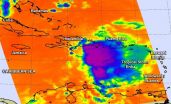NASA sees Tropical Storm Erika dissipate near eastern Cuba
2015-08-31
(Press-News.org) Satellite data from NOAA's GOES-East satellite was made into an animation that showed the demise of former Tropical Storm Erika as it neared eastern Cuba early on August 29.
At NASA's Goddard Space Flight Center in Greenbelt, Maryland, NASA/NOAA's GOES Project compiled three days' worth of imagery from NOAA's GOES-East satellite that showed the movement and changes in former Tropical Storm Erika from August 27 to August 29. The animation showed Erika move through the Leeward Islands and into the Eastern Caribbean Sea, as its center passed just south of Puerto Rico, then crossed over the island of Hispaniola which has the countries of Haiti and the Dominican Republic where the storm weakened. Erika then moved in a westerly direction where it dissipated near eastern Cuba.
On the previous day when NASA's Aqua satellite passed over Erika, infrared data still showed that the storm had powerful thunderstorms with very cold cloud top temperatures near -63F/-53C. Cloud top temperatures that cold have been shown to generate heavy rainfall, and heavy rain has been the biggest problem with Erika, causing flooding in Dominica. On August 27, the Canefield Airport near Roseau, Dominica reported 12.64 inches of rain fell between 2 a.m. to 2 p.m. EDT.
Heavy rainfall continues to be a big threat with Erika's remnants. On August 29, the National Hurricane Center (NHC) noted the remnants are expected to produce total rainfall accumulations of 3 to 6 inches with maximum amounts of 10 inches possible across portions of the Dominican Republic, Haiti and eastern and central Cuba through Sunday, August 30. In addition, rainfall amounts of 1 to 3 inches are expected across the Turks and Caicos Islands as well as the southeastern and central Bahamas through Sunday. Rainfall amounts of 3 to 5 inches, with locally heavier amounts, are possible across southern and central Florida beginning on Sunday.
The NHC issued their final advisory on Erika on Saturday, August 29 at 9:30 a.m. EDT (1330 UTC). At that time the remnants of Erika were estimated near latitude 21.5 North and longitude 75.9 West near the north coast of eastern Cuba. The center was about 130 miles (205 km) east of Camaguey, Cuba, and about 260 miles (420 km) south-southeast of Nassau, Bahamas. The remnants were moving toward the west-northwest near 22 mph (35 kph) and are expected to continue in that direction for another day.
Maximum sustained winds are near 35 mph (55 kph) and had an estimated minimum central pressure is 1011 millibars.
NHC noted that Erika's remnants are expected to move into the southeastern Gulf of Mexico on
Sunday, August 30. All coastal watches and warnings are discontinued.
NHC Forecaster Beven noted in the final discussion on Erika that dynamical computer models suggest that the strong wind shear that has been affecting the storm could relax by the time the system reaches the Gulf of Mexico, and there is a possibility that Erika could regenerate.
INFORMATION:
[Attachments] See images for this press release:


ELSE PRESS RELEASES FROM THIS DATE:
2015-08-31
London, UK - 30 Aug 2015: Recruitment of leukocytes is a hallmark of stent thrombosis, according to results from the PRESTIGE study presented today at ESC Congress1 and published in European Heart Journal.2 The findings suggest that immune cell mediated thrombotic processes may be a realistic target for novel therapies to prevent stent thrombosis.
"Stent thrombosis (ST) is a life-threatening complication of percutaneous coronary intervention and recent large scale clinical registries reported an incidence of up to 0.4-0.6% per year," said principal investigator Professor ...
2015-08-31
How did the ankylosaur get its tail club? According to research from North Carolina State University and the North Carolina Museum of Natural Sciences that traces the evolution of the ankylosaur's distinctive tail, the handle arrived first on the scene, and the knot at the end of the tail followed.
The typical ankylosaur had a wide armored body and a flexible tail. But one group of ankylosaurs - ankylosaurids - also had a tail club that could have served as a useful weapon. These "weaponized" ankylosaurids lived about 66 million years ago, during the Cretaceous period. ...
2015-08-31
LONDON (Aug. 31, 2015) -- Cardiologists failed to identify more than half of basic and about 35 percent of advanced pre-recorded murmurs, but skills improved after a 90 minute training session, according to research presented today at the European Society of Cardiology Congress 2015.
Recent breakthroughs in the transcatheter treatment of aortic and mitral valve disorders provide new therapies for patients, but physicians must be able to detect valve problems in a timely manner for patients to see the full benefit of these advances, said Michael Barrett, MD, the lead ...
2015-08-31
London, UK - 31 Aug 2015: A gene associated with sudden cardiac death in the general population has been identified using implantable cardioverter defibrillator (ICD) monitoring in research presented for the first time at ESC Congress today.1 The research included patients from the DISCOVERY trial and Oregon-SUDS and discovered that a polymorphism in the GNAS gene predicted ventricular tachyarrhythmias and sudden cardiac death.
"This is the first time a gene has been identified using ICD monitoring and then confirmed to be associated with sudden cardiac death in the general ...
2015-08-31
LONDON, UK - 30 August, 2015: In patients with type 2 diabetes and acute coronary syndrome, the glucose-lowering medication lixisenatide did not increase or decrease the rate of cardiovascular (CV) events compared to placebo, according to results of the Evaluation of Lixisenatide in Acute Coronary Syndrome (ELIXA) trial.
The study, presented today at ESC Congress 2015, "demonstrates the cardiovascular safety of lixisenatide", reported Eldrin F. Lewis, MD, MPH, a member of the ELIXA trial's executive committee, a physician in the Cardiovascular Medicine Division at Brigham ...
2015-08-31
LONDON, UK - 30 August, 2015: Patients with type-2 diabetes and cardiovascular disease can safely take the antihyperglycemic drug sitagliptin without an increased risk of cardiovascular complications - even if they have a history of heart failure - a new analysis of the TECOS (Trial Evaluating Cardiovascular Outcomes with Sitagliptin) study shows.
The findings, presented today at ESC Congress 2015, "provide reassurance to patients and prescribers about the cardiovascular safety of sitagliptin" - a dipeptidyl peptidase-4 (DPP-4) inhibitor sitagliptin - according to Paul ...
2015-08-31
London, UK - 31 Aug 2015: Depressed patients have more frequent chest pain even in the absence of coronary artery disease, according to results from the Emory Cardiovascular Biobank presented at ESC Congress today by Dr Salim Hayek, a cardiologist at Emory University School of Medicine in Atlanta, Georgia, US.1 The findings suggest that pain and depression may share a common neurochemical pathway.
"Depression is a common and well recognised risk factor for the development of heart disease," said Dr Hayek. "Patients with known heart disease and depression tend to experience ...
2015-08-31
London, UK - 31 Aug 2015: Retrieval of larger thrombi during intra arterial treatment (IAT) is associated with improved neurological recovery after acute ischaemic stroke, according to a sub study of the MR CLEAN trial presented at ESC Congress today by Dr Anouchska Autar, PhD candidate at the Erasmus Medical Centre in Rotterdam, the Netherlands.1
"Acute ischaemic strokes occur when a blood clot, also called a thrombus, embolises to the brain where it restricts the flow of blood," said Dr Autar. "MR CLEAN was the first trial to show the benefit of IAT to remove blood ...
2015-08-31
India's bread basket, the Indo-Gangetic Plains (IGP), have been classified as a "hot spot" for air pollution. A recent study from the University of Eastern highlights the current status of ozone research in the IGP region, which is agriculturally important and densely populated.
To study adverse effects of ozone, field experiments were conducted with local crop cultivars of mustard (Brassica campestris L.) and rice (Oryza sativa L.), and various growth, physiological (gas-exchange), biochemical and yield parameters were studied throughout the growing season. Ethylenediurea ...
2015-08-31
Many volcanoes are located in densely settled areas. Every time one of these becomes active, large populations are put at risk. Hence, one of the primary goals of the current generation of volcanologists is to develop tools that can accurately predict when volcanoes will erupt. In the case of an impending eruption, these tools are of key importance to those charged with making decisions about what action to take and when. "However, the tools available for predicting eruptions are still in their infancy. We can't always successfully predict an eruption as we lack an understanding ...
LAST 30 PRESS RELEASES:
[Press-News.org] NASA sees Tropical Storm Erika dissipate near eastern Cuba


